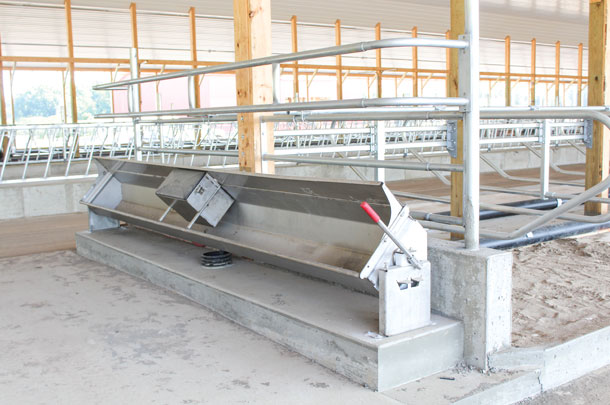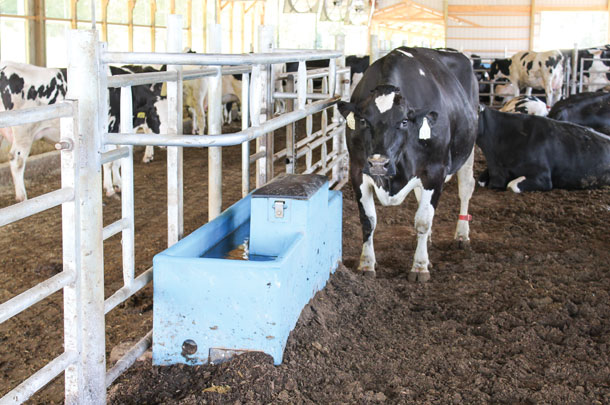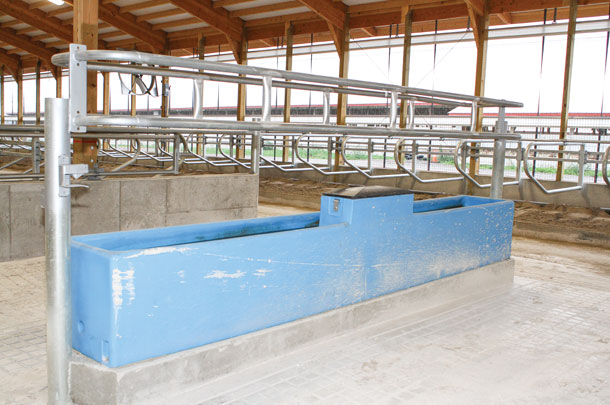When it comes to making milk, cows need one thing more than anything else: water. Milk is mostly water, so it goes without saying it is a vital element in terms of a cow’s nutrient needs.
More than three-quarters of a cow’s total diet is water, and if water intake goes down, so will dry matter intake, resulting in a decrease in milk production.
Water is one of the least expensive yet most important parts of what our dairy cows need every day. But because it isn’t one of the more expensive or time-consuming parts of a farmer’s day such as feed, housing, bedding, preventative care and maintenance, it can be overlooked.

There are many things to keep in mind when making decisions about water supply and placement for a new build or renovation to be sure your cows are getting plenty of clean water. In order to make the best decisions for your farm, let’s start with the basics and go from there.
These are the standards for how much water cows will drink:
- Cows can consume up to 5 gallons of water per minute.
- Lactating cows will drink 30 to 50 gallons of water per day, depending on bodyweight and air temperature.
- Calves less than 2 weeks old will drink little water; older calves could drink up to 8 gallons per day.
Determine the correct size
With these basics in mind, determine the size and quantity of waterers you will need for the number of animals in an area. A simple calculation to determine which size waterer will work best is to designate 3 to 3.5 inches of linear waterer space per cow in a specific area.
To put that into perspective, that equates to a 12-foot-long waterer for every 40 to 50 cows.
Proper placement
Another component is to understand where your dairy cows are drinking to ensure you’re providing adequate access to water. A large amount of a cow’s water intake is from waterers near the center crossover of each pen. Cows want to drink after they are finished eating, so water troughs must be easily accessible from the feedbunk. Watering locations should be no more than 50 feet away from eating areas.

For lactating cows, water should be offered at the milking parlor exit. Cows may drink up to 10 percent of their daily water intake from this location, leading to higher overall water consumption.
This is particularly true for larger operations in warmer locations where cows must wait in hot holding areas or have a long walk back to their stalls. In these situations, you should provide water access in the parlor exit areas or return lanes.
Types of waterers
Here are some things to consider when choosing the type of waterer that will work best for a barn:
- Flow rate and waterer capacity
- Ease of cleaning
- Where the waterer will be located
These three basics will put you on the right track to make the best decisions. Choose a waterer that can refill itself based on the demand. Be sure you select a waterer that matches the management and maintenance plan for cleaning.

If you don’t have time to drain and rinse waterers, consider a tip- or dump-style waterer for quick cleaning. Consider a stainless-steel waterer for less bacteria growth, rust and corrosion. If layout requires waterers to be near open doors where freezing or direct sunlight is an issue, be sure units are equipped with proper heating and flow valves to handle those conditions.
Planning for plenty of water
It’s simple to say the more watering locations available will reduce cow crowding and stress by spreading cows over larger areas of the barn, but you aren’t going to put a waterer every 10 feet. Before installing waterers, be sure to know how many animals will be in various groups and plan for overcrowding conditions.
Try to create easy and free access to water at all times. Take climate into consideration and add waterers during hot weather conditions to prevent heat stress.
Whether you are housing calves, heifers or milk cows, be sure you are providing them with easy access to abundant, clean water. It doesn’t have to break the bank either. With proper planning and an understanding of what your cows need, providing plenty of good water sources will pay off in healthier animals and more milk. It is one of the things that can really be that simple. ![]()
PHOTO 1: This stainless-steel tank incudes splash and water guards.
PHOTO 2: The tip/dump-style allows for easy cleaning and won’t harbor bacteria.
PHOTO 3: This waterer in a maternity pen has water guards and open access to cows across the feedbunk.
PHOTO 4: A crossover alley waterer with water guards is set on an 8-inch curb to provide proper drinking height. Photos courtesy of Seneca Dairy Systems.
Victoria Diegnan worked for Seneca Dairy Systems at the time this article was written.
8 recommendations for waterer installation and maintenance
- Most larger waterers and high-use applications require a concrete platform. A good rule of thumb for curb height is about 8 to 12 inches. However, before pouring concrete platforms, you should refer to the waterer manufacturer’s recommendations of drinking heights for your animals.
- Install a water guard to keep cows from standing in troughs, providing 24 inches of opening between the waterer edge and the rail.
- Have a wall between waterers and freestalls to keep splashed water contained and cows from drinking water while standing in the stalls. This will also prevent debris from accumulating in the waterers. Splash guards are good as well.
- Limit water depth to about 8 inches to optimize water freshness.
- When using electrically heated waterers, you should always check for stray voltage.
- Water temperature of 60º to 65ºF is optimal for maximum intake.
- Take and test water samples (once or twice a year) direct from the waterer and review the results with your vet or nutritionist.
- Keep waterers clean. Cows will drink more water from a clean, fresh source.





